英语 ——一般过去时
语法知识点一般过去时的用法和句型
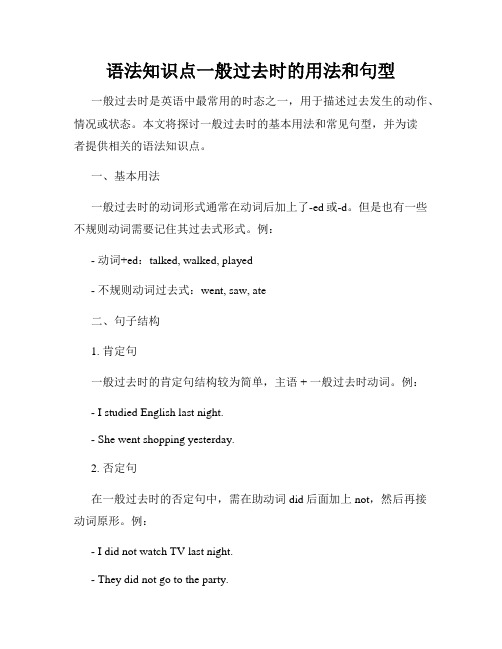
语法知识点一般过去时的用法和句型一般过去时是英语中最常用的时态之一,用于描述过去发生的动作、情况或状态。
本文将探讨一般过去时的基本用法和常见句型,并为读者提供相关的语法知识点。
一、基本用法一般过去时的动词形式通常在动词后加上了-ed或-d。
但是也有一些不规则动词需要记住其过去式形式。
例:- 动词+ed:talked, walked, played- 不规则动词过去式:went, saw, ate二、句子结构1. 肯定句一般过去时的肯定句结构较为简单,主语 + 一般过去时动词。
例:- I studied English last night.- She went shopping yesterday.2. 否定句在一般过去时的否定句中,需在助动词did后面加上not,然后再接动词原形。
例:- I did not watch TV last night.- They did not go to the party.3. 一般疑问句一般过去时的一般疑问句需要将助动词did放在句首,然后将主语放在did后面,接原形动词。
例:- Did you finish your homework yesterday?- Did they visit their grandparents last weekend?三、时间状语一般过去时常与表示过去时间的状语连用,以明确动作或状态发生的时间。
以下是一些常用的时间状语:- yesterday- last week/month/year- in 1990- a few days ago- when I was a child- at that time- in the past四、陈述句和疑问句的回答在陈述句中,我们通常用完整的句子回答,而在疑问句中,我们可以用简略回答或完整回答。
例:- Did you go to the party? - Yes, I did. / No, I didn't.- Did he finish his homework? - Yes, he did. / No, he didn't.五、经常与一般过去时连用的词汇1. 过去连续性的动作:- was/were + 动词-ing:I was playing basketball when she called me. - used to + 动词原形:I used to walk to school when I was young.2. 时间副词:- ago:He moved to New York two years ago.- before:I had never seen such a beautiful scenery before.- when:I was reading a book when the phone rang.3. 愿望:- wish + 一般过去时:I wish I knew the answer.六、一般过去时的注意事项1. 与现在的区别:一般过去时描述过去的动作、情况或状态,与现在时相对应。
一般过去时的语法
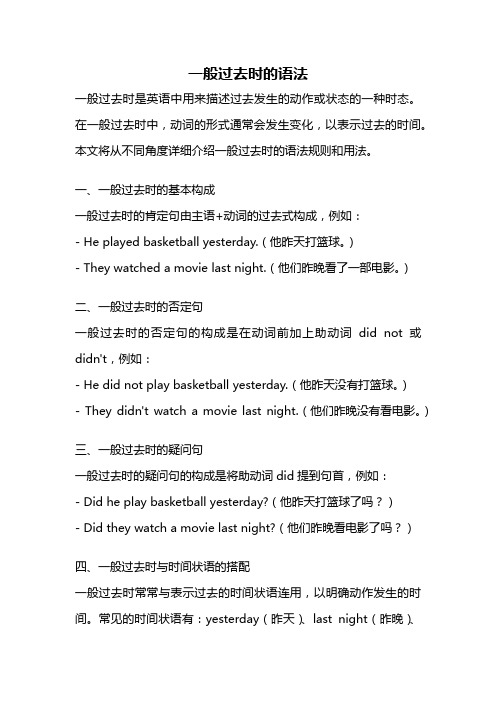
一般过去时的语法一般过去时是英语中用来描述过去发生的动作或状态的一种时态。
在一般过去时中,动词的形式通常会发生变化,以表示过去的时间。
本文将从不同角度详细介绍一般过去时的语法规则和用法。
一、一般过去时的基本构成一般过去时的肯定句由主语+动词的过去式构成,例如:- He played basketball yesterday.(他昨天打篮球。
)- They watched a movie last night.(他们昨晚看了一部电影。
)二、一般过去时的否定句一般过去时的否定句的构成是在动词前加上助动词did not或didn't,例如:- He did not play basketball yesterday.(他昨天没有打篮球。
)- They didn't watch a movie last night.(他们昨晚没有看电影。
)三、一般过去时的疑问句一般过去时的疑问句的构成是将助动词did提到句首,例如:- Did he play basketball yesterday?(他昨天打篮球了吗?)- Did they watch a movie last night?(他们昨晚看电影了吗?)四、一般过去时与时间状语的搭配一般过去时常常与表示过去的时间状语连用,以明确动作发生的时间。
常见的时间状语有:yesterday(昨天)、last night(昨晚)、last week(上周)、in 2010(在2010年)等等。
五、一般过去时的用法1. 表示过去发生的动作或状态She lived in New York for five years.(她在纽约住了五年。
)2. 表示过去经常或反复发生的动作He often went swimming when he was young.(他年轻时经常去游泳。
)3. 表示过去的习惯或常态She always cooked dinner for her family.(她过去总是为家人做晚饭。
一般过去时的定义以及用法概念
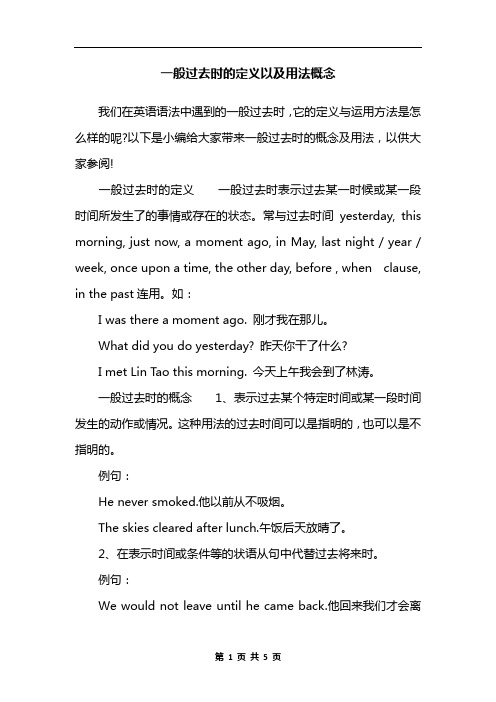
一般过去时的定义以及用法概念我们在英语语法中遇到的一般过去时,它的定义与运用方法是怎么样的呢?以下是小编给大家带来一般过去时的概念及用法,以供大家参阅!一般过去时的定义一般过去时表示过去某一时候或某一段时间所发生了的事情或存在的状态。
常与过去时间yesterday, this morning, just now, a moment ago, in May, last night / year / week, once upon a time, the other day, before , when clause, in the past连用。
如:I was there a moment ago. 刚才我在那儿。
What did you do yesterday? 昨天你干了什么?I met Lin Tao this morning. 今天上午我会到了林涛。
一般过去时的概念1、表示过去某个特定时间或某一段时间发生的动作或情况。
这种用法的过去时间可以是指明的,也可以是不指明的。
例句:He never smoked.他以前从不吸烟。
The skies cleared after lunch.午饭后天放晴了。
2、在表示时间或条件等的状语从句中代替过去将来时。
例句:We would not leave until he came back.他回来我们才会离开。
I didnt go to the party that evening as I started the next day.那天晚上我没有去参加聚会,因为我第二天就要出发。
3、表示现在时间。
这种用法使句子在语气上较为婉转客气,能这样用的动词为数不多,如:hope,wish,want,wonder,think,intend 等。
例句:I hoped you would come and have dinner with us.我希望你能来和我们一起吃饭。
英语语法之一般过去时

am, is → was, are → were
主谓宾结构 Did+ 主语+ v. 原形+ 其他? Yes, 主语+did. No, 主语+didn’t. Did you go to the zoo yesterday? Yes, I did. No, I didn’t.
b.
ed cry—cried try---tried carry---carried D. 单词中只有一个元音字母,其后紧跟一 个辅音字母(重读闭音节结尾的), 双写辅 音字母再加-ed stop---- stopped swim---- swimming
一些不规则动词需要单独记忆: is—was are—were do—did go—went can—could have—had
Grammar
Байду номын сангаас
一。一般过去时 1. 意义:一般过去时用于表示过去发生的动 作或存在的状态。通常与表示过去的时间 状语连用. I go to school every day. I went to school yesterday. 2.一般过去时的构成: 主语+谓语动词的过去式+其他成分
陈述句 a.主系表结构: 主语+ was/ were + 其他. I was at home yesterday. We were at home yesterday. b. 主谓宾结构: 主语+ 动词过去式+ 其他. I went to the zoo yesterday.
E.
3.动词过去式的构成:
A.规则动词直接加- ed look----looked open---- opened ask---- asked B.以不发音e结尾的动词加d, arrive---- arrived live---lived
英语一般过去时语法知识点

英语一般过去时语法知识点英语一般过去时(Simple Past Tense)是表示过去某个时间发生或存在的动作或状态的一种时态。
以下是英语一般过去时的语法知识点:1. 句子结构:主语+ 动词过去式+ 其他成分。
2. 动词过去式的构成:- 一般情况下,直接在动词原形后面加-ed。
例如:play →played,watch →watched,want →wanted。
- 以不发音的字母“e”结尾的动词,在加-ed前先去掉“e”。
例如:live →lived,change →changed。
- 以辅音字母+y结尾的动词,将y变为i再加-ed。
例如:study →studied,carry →carried。
- 一些不规则动词的过去式需要记忆,例如:go →went,eat →ate,see →saw,do →did。
3. 动词过去式的否定和疑问形式:- 否定形式:主语+ did not + 动词原形+ 其他成分。
缩写为didn't。
例如:I didn't play tennis yesterday.- 疑问形式:Did + 主语+ 动词原形+ 其他成分例如:Did you watch the movie last night?4. 一般过去时的时间状语:昨天(yesterday)、上个月(last month)、去年(last year)等表示过去某个具体时间的时间状语。
5. 一般过去时的用法:- 表示过去某个具体时间发生的动作或状态。
例如:I went to the beach yesterday.- 表示过去一段时间内发生的动作或状态。
例如:I lived in London for two years.- 表示过去习惯性的动作或状态。
例如:When I was a child, I always played with my friends.以上就是英语一般过去时的语法知识点。
记得多加练习,熟练掌握一般过去时的用法。
英语一般过去时PPT课件
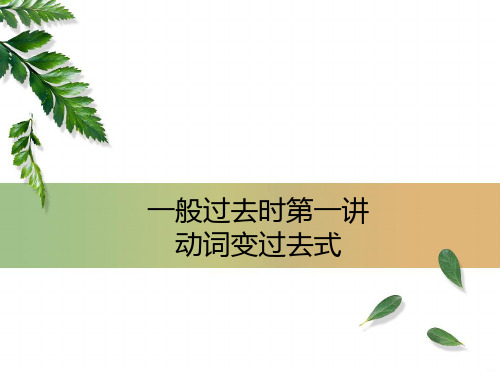
live hope use
lived hoped used
6
3.重读闭音节词, 先双写这个辅音字母,再加—ed
stop plan
stopped planned
7Байду номын сангаас
4. 以“辅音字母+y”结尾的词, 先变“y”为“i”再加—ed
study worry
studied wd orrie
8
不规则动词 过去式的构成
was were did
went had made got
eat
say see stand find
ate
said saw stood found
18
Play Played
19
use used
20
plan planned
21
study studied
22
worry worried
23
stop stopped
一般过去时第一讲 动词变过去式
past no w
futur e
2
动词过去式 的构成
规则动词
regular verbs
不规则动词
irregular verbs
3
规则动词 过去式的构成
1、一般在动词末尾加– ed
look play start
looked played started
5
2、结尾是 e 的动词只加 -- d
否定句: →She didn’t play the violin last night.
肯定句: They swam in the lake yesterday.
否定句: →They didn’t swim in the lake yesterday.
英语时态:一般过去时
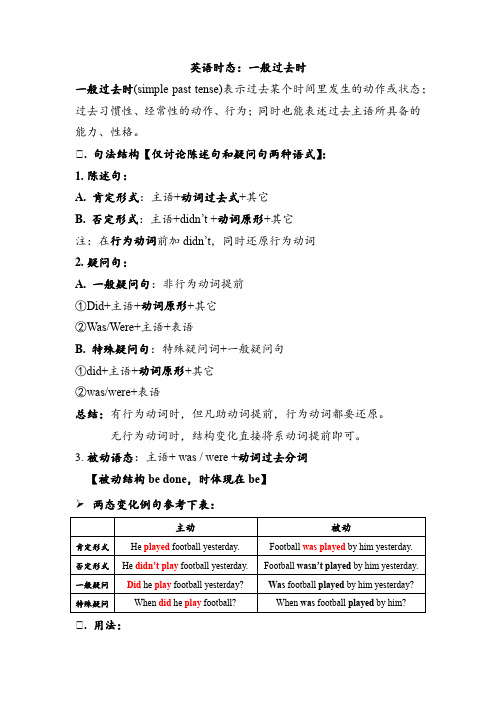
英语时态:一般过去时一般过去时(simple past tense)表示过去某个时间里发生的动作或状态;过去习惯性、经常性的动作、行为;同时也能表述过去主语所具备的能力、性格。
Ⅰ. 句法结构【仅讨论陈述句和疑问句两种语式】:1.陈述句:A. 肯定形式:主语+动词过去式+其它B. 否定形式:主语+didn’t +动词原形+其它注:在行为动词前加didn’t,同时还原行为动词2.疑问句:A. 一般疑问句:非行为动词提前①Did+主语+动词原形+其它②Was/Were+主语+表语B. 特殊疑问句:特殊疑问词+一般疑问句①did+主语+动词原形+其它②was/were+表语总结:有行为动词时,但凡助动词提前,行为动词都要还原。
无行为动词时,结构变化直接将系动词提前即可。
3.被动语态:主语+ was / were +动词过去分词【被动结构be done,时体现在be】➢两态变化例句参考下表:Ⅰ. 用法:1.一般过去时表示在过去某个特定时间发生,也可以表示过去习惯性、经常性的动作。
(一般不强调动作的影响,只说明的事情。
)I talked with Catherine yesterday morning.His mother cooked him breakfast.2.一般过去时常与表示过去的时间状语或从句连用,如:yesterday, last week, in the past, in 1993, at that time, once, during the war, before, a few days ago, when 等。
3.表示过去连续发生的动作时,要用过去时。
这种情况下,往往没有表示过去的时间状语,而通过上下文来表示。
The boy cried for a while,and then drank a cup of tea.4.表示在此之前一段时间内经常或反复的动作。
常与always,never 等连用。
小学英语语法时态一般过去时详解
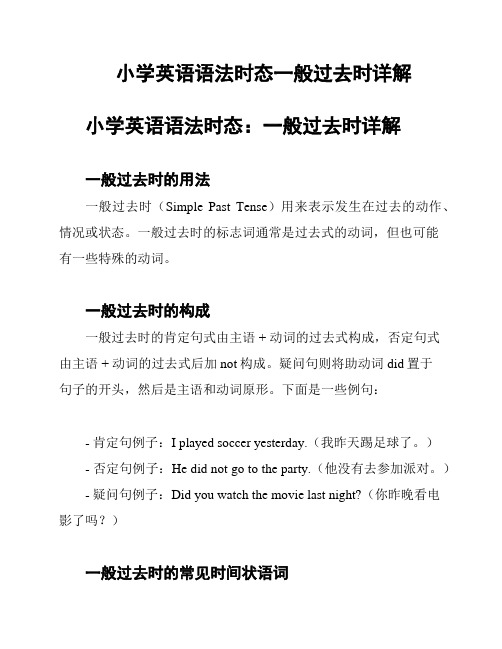
小学英语语法时态一般过去时详解小学英语语法时态:一般过去时详解一般过去时的用法一般过去时(Simple Past Tense)用来表示发生在过去的动作、情况或状态。
一般过去时的标志词通常是过去式的动词,但也可能有一些特殊的动词。
一般过去时的构成一般过去时的肯定句式由主语 + 动词的过去式构成,否定句式由主语 + 动词的过去式后加not构成。
疑问句则将助动词did置于句子的开头,然后是主语和动词原形。
下面是一些例句:- 肯定句例子:I played soccer yesterday.(我昨天踢足球了。
)- 否定句例子:He did not go to the party.(他没有去参加派对。
)- 疑问句例子:Did you watch the movie last night?(你昨晚看电影了吗?)一般过去时的常见时间状语词一般过去时通常会和一些时间状语词一起使用,以明确动作发生的具体时间。
以下是一些常见的时间状语词:- yesterday(昨天)- last week(上周)- two days ago(两天前)- in 1998(在1998年)一般过去时的特殊用法一般过去时有一些特殊的用法需要注意:1. 表示过去经常性的动作或惯。
例如:When I was young, I played soccer every day.(当我年轻时,我每天都踢足球。
)2. 表示过去事实或真理。
例如:The earth revolved around the sun.(地球绕太阳转。
)总结一般过去时用来描述发生在过去的动作、情况或状态。
它的构成简单,使用过去式的动词作为标志词。
通过加入时间状语词,可以更明确地指出动作发生的具体时间。
同时,一般过去时还有一些特殊的用法,需要灵活运用。
>注意:本文内容仅供参考,具体使用时请根据实际情况和教材要求进行调整。
英语时态:一般过去时

英语时态:一般过去时一、定义一般过去时可表示过去某个时间里发生的动作、事情或存在的状态;也可表示过去习惯性、经常性的动作、行为;或表示过去主语所具备的能力、性格。
一般过去时动作发生的时间是“过去”,动作的状态是“一般”。
(注:“一般”态表示的是“动作经常发生或频繁发生”。
)二、时间状语一般过去时常和表示过去某一时间的状语连用,主要包括:yesterday,yesterday morning/afternoon/evening昨天,昨天早上/下午/晚上last night/week/month/year昨晚/上周/上个月/去年the night/week/month/year before last前天夜里/上上个星期/上上个月/前年two minutes/hours/days/weeks/months/years ago两分钟/小时/天/周/月/年前one morning/afternoon/evening在某一早上/下午/晚上that morning/afternoon/evening/day/week/month/summer/year那个早上/那个下午/那个晚上/那天/那周/那个月/那个夏天/那一年just now,at that time,in1990...刚才,当时/在那时,在1990年...三、动词形式一般过去时的动词需用过去式。
动词过去式的构成规则主要包括以下几种:(1)规则动词,在动词原形后直接加ed。
发音规则:在以浊辅音或元音结尾的词后发音/d/,以清辅音结尾的词后发音/t/,以t 或d结尾的词后发音/id/。
示例:ask-asked/t/climb-climbed/d/open-opened/d/pass-passed/t/want-wanted/id/need-needed/id/(2)动词以不发音的e结尾,则只在词尾加d。
发音规则:在以浊辅音或元音结尾的词后发音/d/,以清辅音结尾的词后发音/t/,以t 或d结尾的词后发音/id/。
一般过去时的用法和表示方式

一般过去时的用法和表示方式一般过去时是英语中最常用的过去时态,用来表示已经发生或完成的动作、事件或状态。
本文将详细介绍一般过去时的用法和表示方式。
I. 一般过去时的定义一般过去时用于描述过去某个特定时间发生的动作或状态。
它与现在无关,强调的是过去的事实或经历。
II. 一般过去时的构成一般过去时的肯定句句式为:主语 + 动词过去式 + 其他成分。
例如:1. I went to the store yesterday.2. She played soccer with her friends last weekend.3. They studied English for three hours yesterday.否定句句式为:主语 + did not/didn't + 动词原形 + 其他成分。
例如:1. I didn't go to the store yesterday.2. She didn't play soccer with her friends last weekend.3. They didn't study English for three hours yesterday.疑问句句式为:Did + 主语 + 动词原形 + 其他成分?例如:1. Did you go to the store yesterday?2. Did she play soccer with her friends last weekend?3. Did they study English for three hours yesterday?III. 一般过去时的表示方式1. 定时或时间状语词一般过去时中常常与表示过去时间的词语或短语一起使用,如yesterday(昨天)、last night(昨晚)、in 1999(在1999年)等。
这些时间状语词能够帮助准确表达动作或事件发生的具体时间。
英语语法一般过去时的用法

英语语法一般过去时的用法一般过去时表示过去某个时间里发生的动作或状态;过去习惯性、经常性的动作、行为。
在英语语法中,“时“指动作发生的时间,”态“指动作的样子和状态。
下面是小编为您收集整理的英语语法一般过去时的用法,供大家参考!英语语法一般过去时的用法一般过去时1.一般过去时表示过去某个时间发生的动作或存在的状态,常和表示过去的时间状语连用。
一般过去时也表示过去经常或反复发生的动作感谢。
2.Be动词在一般过去时中的变化:⑴am和is在一般过去时中变为was(was not=wasn’t)⑵are在一般过去时中变为were(were not=weren’t)⑶带有was或were的句子,其否定、疑问的变化和is, am, are 一样,即否定句在was或were后加not,一般疑问句把was或were 调到句首。
3.句中没有be动词的一般过去时的句子否定句:didn’t +动词原形,如:Jim didn’t go home yesterday.一般疑问句:在句首加did,句子中的动词过去式变回原形。
如:Did Jim go home yesterday?特殊疑问句:⑴疑问词+did+主语+动词原形?如:What did Jim do yesterday?⑵疑问词当主语时:疑问词+动词过去式?如:Who went to home yesterday?动词过去式变化规则:1.一般在动词末尾加-ed,如:pull-pulled, cook-cooked2.结尾是e加d,如:taste-tasted3.末尾只有一个元音字母和一个辅音字母的重读闭音节,应双写末尾的辅音字母,再加-ed,如:stop-stopped4.以“辅音字母+y”结尾的,变y为i,再加-ed,如:study-studied5.不规则动词过去式:am,is-was, are-were, do-did, see-saw, say-said, give-gave, get-got, go-went, come-came, have-had, eat-ate, take-took, run-ran, sing-sang, put-put, make-made, read-read, write-wrote, draw-drew, drink-drank, fly-flew, ride-rode, speak-spoke, sweep-swept, swim-swam, sit-sat过去时练习写出下列动词的过去式is\am_______ fly_______ plant_______ are_______drink_______ play_______ go_______ make_______does_______ dance_______ worry________ ask_______taste_______ eat_______ draw________ put_______throw_______ kick_______ pass_______ do_______语法讲解一般过去时也叫单纯过去时。
英语一般过去时
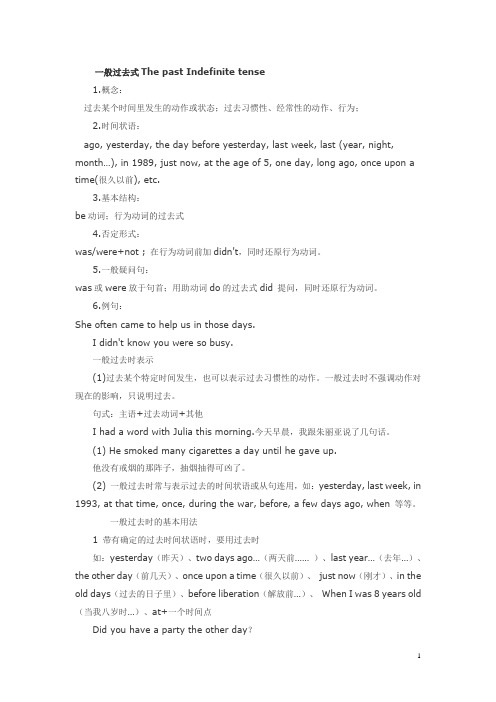
一般过去式The past Indefinite tense1.概念:过去某个时间里发生的动作或状态;过去习惯性、经常性的动作、行为;2.时间状语:ago, yesterday, the day before yesterday, last week, last (year, night, month…), in 1989, just now, at the age of 5, one day, long ago, once upon a time(很久以前), etc.3.基本结构:be动词;行为动词的过去式4.否定形式:was/were+not ; 在行为动词前加didn't,同时还原行为动词。
5.一般疑问句:was或were放于句首;用助动词do的过去式did 提问,同时还原行为动词。
6.例句:She often came to help us in those days.I didn't know you were so busy.一般过去时表示(1)过去某个特定时间发生,也可以表示过去习惯性的动作。
一般过去时不强调动作对现在的影响,只说明过去。
句式:主语+过去动词+其他I had a word with Julia this morning.今天早晨,我跟朱丽亚说了几句话。
(1) He smoked many cigarettes a day until he gave up.他没有戒烟的那阵子,抽烟抽得可凶了。
(2) 一般过去时常与表示过去的时间状语或从句连用,如:yesterday, last week, in 1993, at that time, once, during the war, before, a few days ago, when 等等。
一般过去时的基本用法1 带有确定的过去时间状语时,要用过去时如:yesterday(昨天)、two days ago…(两天前…… )、last year…(去年…)、the other day(前几天)、once upon a time(很久以前)、just now(刚才)、in the old days(过去的日子里)、before liberation(解放前…)、When I was 8 years old (当我八岁时…)、at+一个时间点Did you have a party the other day?前几天,你们开了晚会了吗?Lei Feng was a good soldier.雷锋是个好战士。
英语语法系列_一般过去式介绍
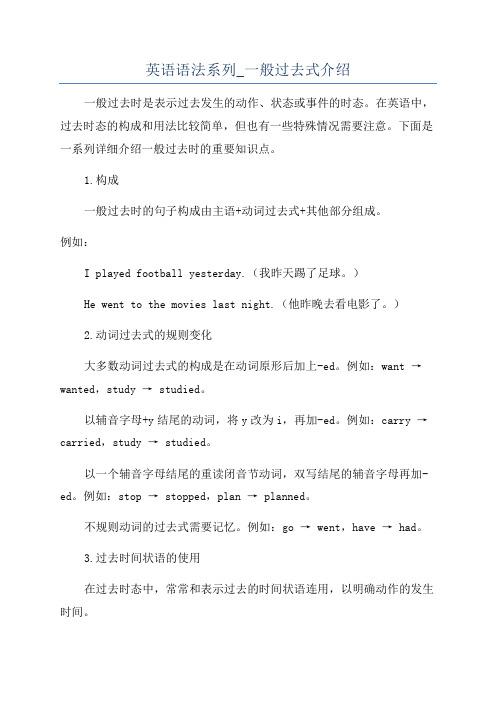
英语语法系列_一般过去式介绍一般过去时是表示过去发生的动作、状态或事件的时态。
在英语中,过去时态的构成和用法比较简单,但也有一些特殊情况需要注意。
下面是一系列详细介绍一般过去时的重要知识点。
1.构成一般过去时的句子构成由主语+动词过去式+其他部分组成。
例如:I played football yesterday.(我昨天踢了足球。
)He went to the movies last night.(他昨晚去看电影了。
)2.动词过去式的规则变化大多数动词过去式的构成是在动词原形后加上-ed。
例如:want → wanted,study → studied。
以辅音字母+y结尾的动词,将y改为i,再加-ed。
例如:carry → carried,study → studied。
以一个辅音字母结尾的重读闭音节动词,双写结尾的辅音字母再加-ed。
例如:stop → stopped,plan → planned。
不规则动词的过去式需要记忆。
例如:go → went,have → had。
3.过去时间状语的使用在过去时态中,常常和表示过去的时间状语连用,以明确动作的发生时间。
例如:yesterday(昨天),last week(上周),in 1990(在1990年)。
4.一般过去时的用法4.1表示过去的一些时间点的动作或事件。
例如:I visited Paris last month.(上个月我去了巴黎。
)They went to the park yesterday.(他们昨天去了公园。
)4.2表示过去经常发生的动作或状态。
例如:We always walked to school when we were children.(我们小时候经常走路去上学。
)She often cooked dinner for her family.(她经常给家人做晚饭。
)4.3表示过去习惯性的动作或状态。
例如:He used to live in London.(他过去住在伦敦。
初中英语知识点一般过去时
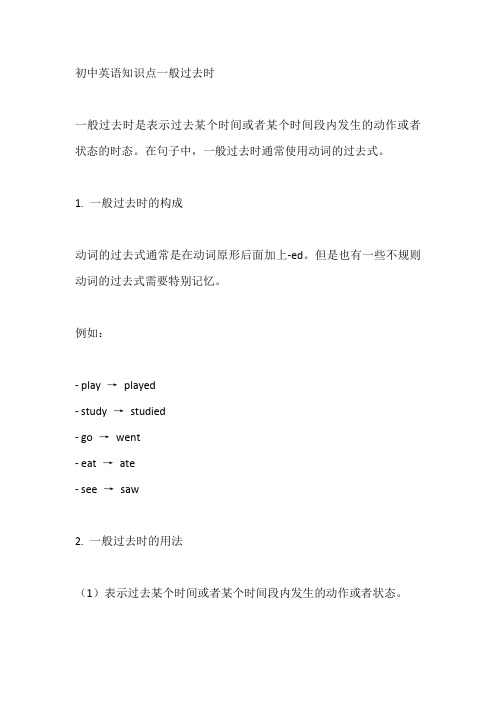
初中英语知识点一般过去时一般过去时是表示过去某个时间或者某个时间段内发生的动作或者状态的时态。
在句子中,一般过去时通常使用动词的过去式。
1. 一般过去时的构成动词的过去式通常是在动词原形后面加上-ed。
但是也有一些不规则动词的过去式需要特别记忆。
例如:- play →played- study →studied- go →went- eat →ate- see →saw2. 一般过去时的用法(1)表示过去某个时间或者某个时间段内发生的动作或者状态。
例如:- I watched a movie yesterday.(我昨天看了一部电影。
)- She lived in New York for three years.(她在纽约住了三年。
)(2)表示过去的习惯或者经常性的动作。
例如:- When I was young, I played soccer every day.(我小时候每天都踢足球。
)- He always ate breakfast at 7:00 am.(他总是在早上7点吃早餐。
)(3)表示过去的真实条件。
例如:- If it rained, we stayed inside.(如果下雨了,我们就呆在屋里。
)(4)表示过去的虚拟条件。
例如:- If I had more money, I would buy a new car.(如果我有更多的钱,我会买一辆新车。
)3. 一般过去时的时间状语一般过去时常常和表示过去时间的时间状语连用,例如:- yesterday(昨天)- last week(上周)- two years ago(两年前)- in 1999(在1999年)- at that time(那个时候)以上就是初中英语知识点:一般过去时的介绍。
希望对大家有所帮助。
小学英语小学英语语法课件-一般过去时 (共37张PPT) 全国通用
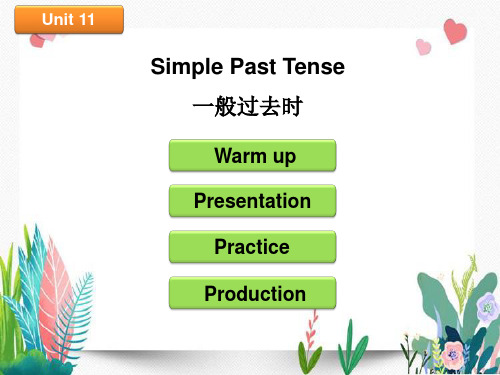
Presentation Sentences
一般过去时的主要用法和概念:一般过去时表示在过去某时 发生的动作或存在的状态,常与表示过去的时间状语 yesterday, last week, ago等连用。
一般过去时的用法: ① 表示过去时间里发生的动作或存在的状态,常与表示过去 的时间状语yesterday, last year, ago, the day before, yesterday, just now等连用。 ② 表示在过去一段时间里,经常性或习惯性的动作或状态, 常与always, often, usually等连用。
一般疑问句:a_t_t_h_e_l_iv_e__s_h_o_w_?_______________________ How many people were there at the
对划线部分提问:_l_iv_e__s_h_o_w_?________________________
Practice Oral Practice
Unit 11
Simple Past Tense 一般过去时
Warm up Presentation
Practice Production
Warm up
Free talking: What do you usually do on weekdays?
I usually get up at 6:00, I put on my clothes, make the bed, brush my teeth, wash my face. I have breakfast at 6:40, then wipe the table. I go to school at 8:00, and eat lunch at 12:00. Then I usually do my housework at 6:00, take a bath at 7:00, and watch TV at 7:45, and go to bed at 9:00.
一般过去时_小学六年级英语
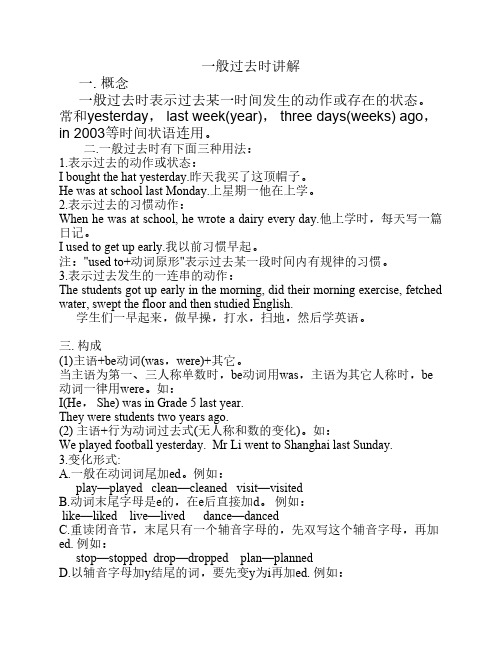
一般过去时讲解一. 概念一般过去时表示过去某一时间发生的动作或存在的状态。
常和yesterday, last week(year), three days(weeks) ago,in 2003等时间状语连用。
二.一般过去时有下面三种用法:1.表示过去的动作或状态:I bought the hat yesterday.昨天我买了这顶帽子。
He was at school last Monday.上星期一他在上学。
2.表示过去的习惯动作:When he was at school, he wrote a dairy every day.他上学时,每天写一篇日记。
I used to get up early.我以前习惯早起。
注:"used to+动词原形"表示过去某一段时间内有规律的习惯。
3.表示过去发生的一连串的动作:The students got up early in the morning, did their morning exercise, fetched water, swept the floor and then studied English.学生们一早起来,做早操,打水,扫地,然后学英语。
三. 构成(1)主语+be动词(was,were)+其它。
当主语为第一、三人称单数时,be动词用was,主语为其它人称时,be 动词一律用were。
如:I(He, She) was in Grade 5 last year.They were students two years ago.(2) 主语+行为动词过去式(无人称和数的变化)。
如:We played football yesterday. Mr Li went to Shanghai last Sunday.3.变化形式:A.一般在动词词尾加ed。
例如:play—played clean—cleaned visit—visitedB.动词末尾字母是e的,在e后直接加d。
一般过去时
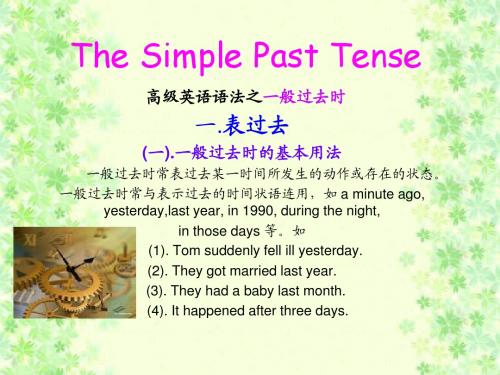
(二).一般过去时用于since 从句
主句的谓语动词如用现在完成时,其后接的since引导的从句一般 须用一般过去时。如: (1).You haven’t changed much since we last met. (2).It’s been over a year since I came back from the countryside. 如果since从句的谓语动词是无限动词或静态动词的一般过去时, 则一般仍表动作或状态的结束,并无持续性,如: (3).It’s been a long time since I lived here.我不住这里已经好久了。 (4).It has been ten years since I was a teacher.我不当老师已有 十年了。
The Simple Past Tense
高级英语语法之一般过去时
一.表过去
(一).一般过去时的基本用法
一般过去时常表过去某一时间所发生的动作或存在的状态。 一般过去时常与表示过去的时间状语连用,如 a minute ago, yesterday,last year, in 1990, during the night, in those days 等。如 (1). Tom suddenly fell ill yesterday. (2). They got married last year. (3). They had a baby last month. (4). It happened after three days.
无限动词变为有限动词时,其一般过去时表已完成的动作。而一 般情况下,无限动词仍表持续的动作,如: (6). I sat in the chair and my cat sat on the rug. (7). They ate in the school’s dining room…He looked at her untouched plate. “ You’re not eating.” he said. 当然,一般过去时表重复动作时,也不会完成,如: (8). In those days she went to see her father in the hospital ever day .
一般过去时知识总结

一般过去时一般过去时是英语语法的一种,表示过去某个时间里发生的动作或状态。
一般过去时的动词通常用动词的过去式形式来表示,而动词的过去式是在动词原形的基础上变化的。
动词的过去式可分为规则动词和不规则动词。
规则动词的过去式变化如下:(1)一般情况下,动词词尾加ed ,如:worked played wanted acted(2)以不发音的 e 结尾动词,动词词尾加d,如:lived moved decided declined hoped judged raised wiped(3)以辅音字母+ y结尾的动词,把y变为i 再加ed,如:studied tried copied justified cried carried embodied emptied (4)以一个辅音字母结尾的重读闭音节动词,双写词尾辅音字母,再加ed,如:stopped begged fretted dragged dropped planned dotted dripped(5)注:不规则动词的过去式变化规律性不强,须多加记忆。
go - went,make - made,get - got ,buy - bought ,come - came ,fly-flew ,is/am-was,are-were ,see-saw ,bring-brought,do-did,teach-taught, think-thought, say-said,sit-sat. read-read, spend-spent, eat-ate,give-gave,sit-sat,tell-told,write-wrote,feel-felt,find-found,hear-heard,know-knew,put-put,grow-grew,take-took,catch-caught,come-came,become-became,swim-swam,sweep—swept,sing—sang,draw—drew,时间标志:yesterday(昨天), last week(上周), last month(上个月), last year(去年), two months ago(两个月前), the day before yesterday(前天),in 1990 (在1990年), in those days (在那些日子里)等表示过去的时间状语。
- 1、下载文档前请自行甄别文档内容的完整性,平台不提供额外的编辑、内容补充、找答案等附加服务。
- 2、"仅部分预览"的文档,不可在线预览部分如存在完整性等问题,可反馈申请退款(可完整预览的文档不适用该条件!)。
- 3、如文档侵犯您的权益,请联系客服反馈,我们会尽快为您处理(人工客服工作时间:9:00-18:30)。
时间标志词大集合
last系列 yesterday 系列
ago 系列
in+过去年份
时间,你掐的准吗?
①He went to school by bus last week. ②They will go to school by bus tomorrow. ③She is going to London next week. ④Lily was so happy yesterday afternoon. ⑤I ate eggs and two pieces of bread this morning. ⑥Mike goes to school by bus every day.
综合练习
一、写出下列动词的过去式 is\am_________ fly_______ see________ are _____ buy_________ play_______ go________ make ___ does_________ dance________ask _____like_____ eat__________ draw________ run_________
牛刀小试
My brother was in the park just now.
否定句:__________________________________________ 一般疑问句:
_______________________________________ 否定回答:____________ 对划线部分提问: ______________________________________
whose
where
which how
when why
how much
who
how long
句子结构--be动词系列
肯定句结构:主语+was\were+其他成分 否定句结构:主语+wasn't\weren't+其他成分 一般疑问句结构:Was\Were+主语+其他成分?
Yes,主语+was\were. No,主语+wasn't\weren't. 特殊疑问句结构:特疑词+was\were+主语+其他?
句子结构分类脑图
be动词现在与过去
be动词口诀 要牢记
主语
be动词 现在时 过去时
单数
复数
用be动词适当形式填空
用be动词适当形式填空
was was were was was was
句子结构--be动词系列
They were happy last night.
They weren't happy last night. 肯定句结构: 否定句结构:
She was in the park just? 肯定句结构:主语+was\were+其他成分 特殊疑问句结构:特疑词+was\were+主语+其他?
回想一下,特殊疑问词都有哪些呢?
大胃王计时大赛
where
what
how many
牛刀小试
My brother was in the park just now.
否定句:_M__y_b__ro_t_h_e_r_w__a_s_n_'t_\_w_a_s__n_o_t_i_n_t_h_e__p_a_r_k_j_u_s_t_n_o_w_ .
一般疑问句并做否定回答:
__W_a_s_y_o_u__r_b_r_o_th_e_r _in__th_e_p_a_r_k_j_us_t_n_o_w_?_________
_N__o_,h_e__w_a_s_n_'t_. __________________________
对划线部分提问: _W__h_er_e__w_a_s_y_o_u_r__b_ro_t_h_e_r _ju_s_t _n_o_w_?___________
TIP:在肯定句中遇到I\we\my\our时,变疑问句 需要分别改成you\your.
英语 ——一般过去时
第一部分
课程引入
Long long ago, there was a king. He liked new clothes.One day, two men visited the king. "My king, we can make new clothes for you." The king was happy.
综合练习
目录
第一部分:一般过去时定义 第二部分:时间标志词 第三部分:动词过去式变化 第四部分:句式变换 第五部分:综合练习
时间标志词
①I was very tired yesterday. ② He went to Shanghai last Friday. ③ They were in America in 2006. ④She was a student 20 years ago.
肯变一般疑问,was\were要提前,首字母大写, 句末问号加上去
句子结构--be动词系列
She was in the park just now.(划线部分提问)
Where was she just now? 肯定句结构:主语+was\were+其他成分 特殊疑问句结构:
句子结构--be动词系列
句子结构--be动词系列
They were happy last night.
They weren't happy last night. 肯定句结构:主语+was\were+其他成分 否定句结构:主语+wasn't\weren't+其他成分
肯变否,was\were后加not
句子结构--be动词系列
They were happy last night. Were they happy last night? 肯定句结构:主语+was\were+其他成分 一般疑问句结构:
句子结构--be动词系列
They were happy last night.
Were they happy last night? 肯定句结构:主语+was\were+其他成分 一般疑问句结构:Was\Were+主语+其他成分?
